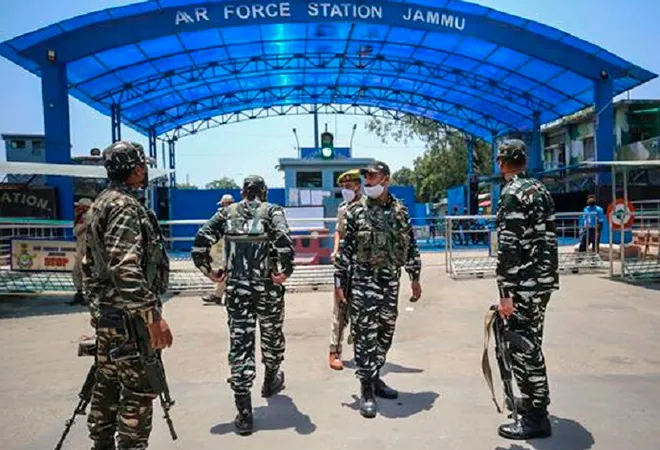The only thing surprising about the drone attack on the Jammu Air Force Station in the wee hours of June 27 was that some people were surprised that such an attack took place. Security agencies in India have for some time been anticipating, even fearing, the possible use of drones to target sensitive locations. The first signs that drones were a new element that had been introduced in the asymmetric war against India came a couple of years ago when they were used to drop weapons and drugs along the Punjab border. After that, it was only a matter of time that drones would be deployed in Jammu and Kashmir by terrorists and their handlers in Pakistan.
Even so, the targeting of a military installation by an armed drone is both a serious escalation and a dangerous portent of things to come. What is more worrisome is that despite multiple warnings, the attack on the airbase, and the subsequent sighting of drones over the military base in Jammu, show how unprepared India was in combating this threat. Three days after the Jammu attack, investigators are still not sure whether the drone was a crude, commercially available version that had been rigged to drop an explosive charge, or it was a more sophisticated drone that could fly longer distances and attack with greater accuracy; there is also no information on whether the drone came from across the border or was launched from the vicinity of the airbase. In either case, the implications are extremely serious: if it was launched from around the air force station, then it means that terrorists inside J&K have acquired the technology and capability to use drones in an offensive mode; if it came from across the border, then it means that the messaging from the Pakistani side is very clear – they know the glaring gaps in our security and are demonstrating their capability to catch us unawares.
What the security agencies are also trying to figure out are the who-did-it and why-it-was-done of this attack. Although no terrorist organisation, not even the new-fangled ones with liberal, secular names, has taken responsibility, there is a sort of consensus among the security agencies that this attack couldn’t have happened without the Pakistan army’s involvement. The simple fact of the matter is that there are no non-state actors in Pakistan. This is an alibi that is used to distance the Pakistani state from its terrorist auxiliaries. Therefore, the attack was most likely the handiwork of one of these proxies of the Pakistan military establishment, most likely the Lashkar-e-Taiba.
Although no terrorist organisation, not even the new-fangled ones with liberal, secular names, has taken responsibility, there is a sort of consensus among the security agencies that this attack couldn’t have happened without the Pakistan army’s involvement. The simple fact of the matter is that there are no non-state actors in Pakistan
As for the ‘why’ part, there are broadly three or four theories that appear plausible: one, it was a response to the bomb blast outside the house of the UN-designated international terrorist, Pakistan’s favourite son, Hafiz Saeed. Many Pakistanis, without a shred of evidence, have pointed fingers at India and it is possible that the Jammu attack was a joint venture of the Pakistan army and the Lashkar-e-Taiba to demonstrate their ability to retaliate to alleged Indian involvement in the Lahore blast; two, the Pakistanis are spooked by the political outreach in J&K and have been working overtime through their proxies to sabotage the fledgling political process set in motion by the Prime Minister’s meeting with political stakeholders from the Union Territory. The sudden spike in targeted killings in the Valley, the attempt to plant an IED in a Hindu-dominated area of Jammu, and the drone attacks were a way to demonstrate that they can short-circuit this process; three, it was the result of rumoured disquiet among sections of the Pakistani ‘deep state’ over the back-channel talks that are believed to be taking place between India and Pakistan and which have resulted in the ceasefire along the Line of Control since February. The drone strike in Jammu was an attempt to undermine the ceasefire agreement and start a spiral that would result in the LoC once again heating up; finally, there are some who believe that the FATF decision to retain Pakistan on the ‘grey list’ provoked the Pakistanis to lash out against India. But this seems a little far-fetched.
Regardless of the ‘whys’ and ‘wherefores’ of the attack, what should concern India is the fact that it was caught off guard. Forget being unable to thwart the attack, India also had no matching response ready. Clearly, this is something that needs to be fixed, and fast. The response to this new and deadly challenge cannot be only defensive; it must also have a robust offensive dimension. We need to recognise that there are no ready-made solutions to defending against drones. It is also important to understand that it doesn’t make sense to “fire a $2 million missile at a $10 empty tent and hit a camel in the butt” (to use the evocative phrase of former US president George W Bush). Even so, there are different technologies available to counter drones. They aren’t all perfect, nor are they all cheap. Most importantly, it isn’t possible to have a sort of theatre defence against drones. But within these limitations and depending on the threat perceptions, countermeasures need to be put in place.
The counteroffensive part of the equation is just as important. The sort of technological issues in countering drones that India faces are the same for Pakistan. Using drones to mount a sneaky attack against a military target is a game two can play. The plausible deniability is also available to both sides. What is important is to send a message across that there will be a response to any such escalatory measure. Ideally, when the first time drones came from across the border to drop weapons in Punjab, India should have retaliated. But after Jammu, paying the Pakistanis back in the same coin is absolutely critical.
The counteroffensive part of the equation is just as important. The sort of technological issues in countering drones that India faces are the same for Pakistan. Using drones to mount a sneaky attack against a military target is a game two can play. The plausible deniability is also available to both sides. What is important is to send a message across that there will be a response to any such escalatory measure
The retaliation is, however, just one part of India’s response. What the security forces need to do is to now game their response, and pre-select their targets, in the event of more such attacks. In fact, there should be a constant exercise to game new threats, anticipate them and work out how these will be responded to. For instance, if hostilities break out along the LoC and Pakistanis use drones to attack Indian posts, what will be our response? If other such technologies and tactics are used to hit India, how will we react? What will be our reaction time? What will be the targets we will hit? Will we allow Pakistanis the luxury of an alibi and keep looking for incontrovertible evidence before we take action?
This commentary originally appeared in News18.
The views expressed above belong to the author(s). ORF research and analyses now available on Telegram! Click here to access our curated content — blogs, longforms and interviews.




 PREV
PREV


